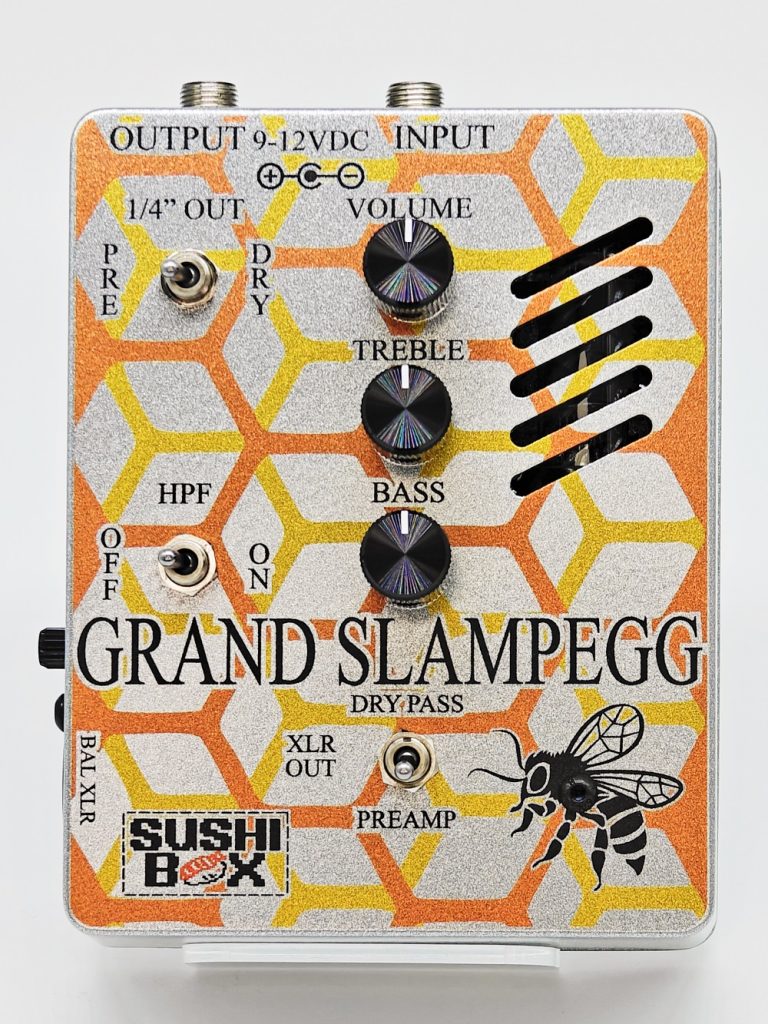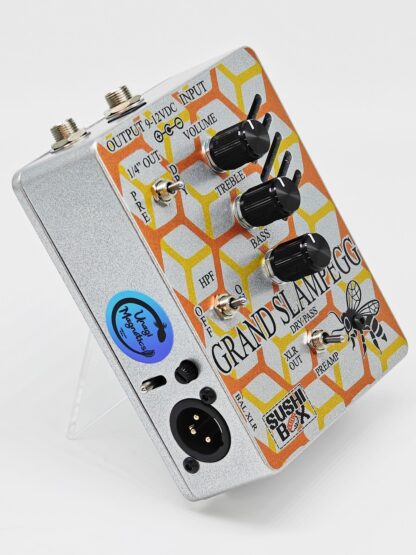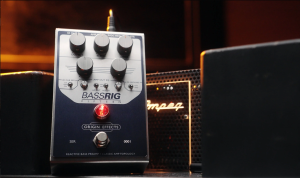B-15 DNA in a Modern Tube Pedal
The Grand Slampegg from Sushi Box FX is a tube-powered preamp pedal designed to capture the spirit, tone, and feel of the iconic Ampeg B-15 Portaflex — the amplifier that defined the sound of recorded bass in the 1960s and beyond. Hand-built in small batches and powered by a real 12AX7 tube, this pedal is part of a growing movement of boutique builders bringing studio-grade tones to the pedalboard world.
What sets the Grand Slampegg apart is its targeted mission: not to be a Swiss-army preamp, but rather to emulate the sonic character and response of the B-15, an amp that still stands as one of the most revered tools for bass tone shaping in history.

The Ampeg B-15 and Its Lasting Impact
Before diving into the pedal, let’s zoom out for a second. The Ampeg B-15 Portaflex, introduced in 1960, was a compact flip-top bass combo amp known for its rich, warm, and punchy tone, thanks to its tube circuitry, simple EQ, and closed-back cabinet with a single 15″ speaker. It became the go-to amp for session players, especially in Motown, Stax, and New York’s studio scene.
Names like James Jamerson, Donald “Duck” Dunn, and Chuck Rainey played through B-15s on countless records, and its pillowy low end, smooth midrange, and organic compression became baked into the DNA of modern bass tone.
But the B-15 is big, heavy, and expensive. So for today’s bassists — especially those playing live or recording direct — the Grand Slampegg offers a portable, affordable, and musical tribute to that era-defining sound.
Design and Features: Simplicity That Speaks Volumes
The Grand Slampegg is powered by a genuine 12AX7 preamp tube operating at high voltage (internal boost from a 9V supply), allowing it to behave like a real tube amp rather than a tube-flavored simulator. That’s a crucial difference: it reacts dynamically to your playing and has that slightly compressive, touch-sensitive character that makes tube gear so addictive.
The layout is minimal, but deceptively deep:
- Gain – Controls how hard you hit the tube. At low settings, it’s clean and full; turn it up and you get that pillowy breakup the B-15 is known for.
- Bass / Treble – A two-band EQ similar to the original B-15’s tone stack, voiced to offer broad sculpting without ever sounding harsh.
- Master Volume – Lets you control overall output without affecting the tube’s behavior.
- Deep switch (on some versions) – Engages a low-end boost reminiscent of early Ampeg voicing, great for reggae, dub, or soul lines.
The pedal has both instrument-level and line-level output, making it easy to slot into a pedalboard, run into an amp’s return, or go direct into an interface or FOH system.
Tone
Plug into the Grand Slampegg and the first thing you’ll notice is the weight of the tone — not in volume, but in density and presence. It fills up space in a mix the way a great amp does, especially with a passive P-style bass or flatwound strings.
The key characteristics are all there:
- Smooth, rounded lows that feel supportive but never bloated.
- Soft-edged mids that hold the groove without pushing aggressively.
- Gently rolled-off highs that stay articulate but warm — ideal for fingerstyle, R&B, and vintage funk.
Unlike some tube preamps that lean toward modern grit or aggressive drive, the Grand Slampegg prioritizes subtlety, bloom, and tone shaping. That makes it ideal for studio-style applications, warm live rigs, or as a foundational tone shaper on your board.
And yes — it breaks up when pushed. But the breakup is velvety and musical, not jagged or compressed. Think Jamerson with the gain halfway up, or a slightly overdriven studio channel strip.

Because it’s voiced so naturally and keeps low-end intact, the Grand Slampegg is extremely flexible as a platform. You can use it:
- At the front of your chain as your always-on preamp.
- Into a power amp or powered cab for a full mini-rig experience.
- After drive/fuzz pedals to warm up harsh digital sounds.
- Before chorus, reverb, or delay to maintain definition in ambient settings.
It also works well as a recording tool — slotting it into your DI path gives you that elusive “amp in the room” feel with minimal fuss.
Pros and Cons
Pros:
- Truly warm, musical tube tone modeled after a studio legend
- Compact and pedalboard-friendly with full-voltage tube operation
- Preserves low-end — perfect for traditional and modern bass tones
- Smooth breakup that enhances dynamics without harshness
- Simple, intuitive controls — easy to dial in great sounds fast
- Excellent for both live use and studio direct recording
Cons:
- No mid control — may require pairing with other EQ if shaping is needed
- Not designed for aggressive distortion or modern grit
- Limited availability due to boutique production scale
- May not suit players seeking ultra-clean hi-fi or aggressive preamp tone
Conclusion
The Sushi Box Grand Slampegg is not trying to reinvent the wheel — it’s trying to preserve one of the most beloved wheels ever made and offer it to a new generation of players in a compact, efficient form. And in that mission, it succeeds beautifully.
For bassists chasing that vintage studio tone, especially in settings where a full B-15 isn’t practical or affordable, this pedal is a godsend. It captures the essence of what made that amp great — the musical compression, the EQ shape, the tube warmth — and brings it to your fingertips in a pedal that’s easy to use and hard to turn off.
If you’re into Motown grooves, soul lines, dub foundations, or just want your bass to sit deeper and more confidently in a mix, the Grand Slampegg should be on your radar. It’s not flashy, and it’s not aggressive — but it has tone for days, and it feels like a classic.





